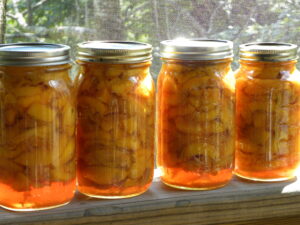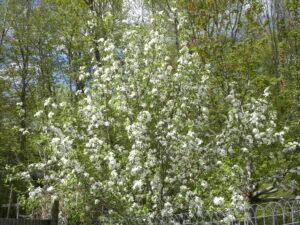The first principle of permaculture, Observe and Interact, is one I return to again and again. This is how it is meant to be since the principles are not a checklist to work through and be done with but a way of looking at the world that you try to deepen over time.

Bumblebee on Anise Hyssop
Observe and Interact basically tells us to pay attention, engage, and learn. This seems like it should be easy for human beings with our capacity for thinking, reflecting and remembering. At the moment, however, our culture does not seem to encourage critical thinking, seeing reality, or empowered action. It is a complex, convoluted and often overwhelming world of information these days. This is part of why the garden is such a great place to take in these principles. This sort of embodied and direct learning and feedback greatly helps us to grasp and internalize all the principles of permaculture.
So, it follows that the more that we garden and homestead the more we understand the importance of principle number one: Observe and Interact. This year we found ourselves particularly noting the benefits we get and the problems we avoid by paying attention.
It has always been my goal to carefully inspect every part of our three or so acres in use on a regular basis, maybe every other week. While I have not met that goal, I did manage to keep an eye on this land enough to catch and deal with some problems before they got out of hand. Here are some examples.

Dandelions in Spring
I have been working for years to build our soil and encourage vibrant plant growth while being picky about what plants live here. I have a long list of plants I like, including some that other people detest like dandelions, but there also plenty which I do not want taking up residence here, including some that can be very persistent. My experience is that stopping plants from establishing themselves is much easier than trying to remove them later.
This year we had garlic mustard (Alliaria petiolata) and Oriental bittersweet (Celastrus orbiculatus) try to move in. I found the garlic mustard in my front orchard where I spend a lot of time. There were just a few plants when I noticed and identified it and pulled it out. Throughout the season I walked by the area and pulled up the few straggly new ones that tried to come back. I will keep an eye on it next year, but don’t foresee much of a problem. Later in the season, I was visiting the goats when I noticed a vine climbing up the fence. It was about 2 feet tall and when we dug it out the orange root confirmed that, yes, it was Oriental bittersweet. It hasn’t come back yet but we will keep watching. We’ve had this happen before with bittersweet and it does sometimes take a few rounds to get out all of the root.
While most people think of these plants as impossible to get rid of, especially without chemicals, we find any plant we can keep cut back eventually dies. The smaller it is when we start the process the faster it all goes. Again, noticing is the key. Of course, we also have goats if we needed to really keep something knocked back that has gotten established – like poison ivy was when we first got here!

This would be too many peaches!
As you know from my last post, I had a fabulous peach season this year. It would not have been quite as good if I had not been tuned into them long before they were ripe. We pruned in the late winter and thinned after fruit set in the spring. I felt like we did a good job, but another walk through in early summer alerted me to some issues. First, I tend to leave enough fruit on to make up for loss from other animals, but for some reason we had very little theft by squirrels this year. So I needed to do another round of thinning to prevent branches from breaking and to let the remaining fruit grow nice and big. Also, I could see the trees were getting very bushy and full. Although it is not the recommended time to do a lot of pruning, we have found that a mid summer cut back is useful for our more vigorous trees. Otherwise, they put on so much leaf growth they shade the peaches too much to ripen well. So far, we have not seen a downside to careful summer pruning. Certainly this year we had a spectacular season with lots of delicious fruit, as I reported in August. Stay tuned for my harvest summary update in about a month for the final numbers!

Songbird nestlings need a lot of food
This year many people experienced high animal pest numbers. We had some problems for sure. The chipmunks stole most of my strawberries, and we had many gorgeous songbirds visiting us – and taking most of our berry crop. But our fences generally held, keeping the deer, porcupines, raccoons and groundhogs at bay. In July, however, I noticed something nibbling the winter squash leaves in one of the orchards. Just a few, but still… the next day a few more were gone and a few young squash had been gnawed on. So, we scouted around the area very carefully and, yes, found a den with multiple entrances. We were unsure if he/she scaled a fence or

Young, Vulnerable Winter Squash
tunneled in but we acted fast to refill the holes and remove the critter and managed to save a lot of our produce for the year.

Grey Tree Frog
Although my observations are particularly tuned in to catch problems, it’s also important to see the beauty, health and productivity all around me. No matter the season or the stressors, there’s always something to appreciate.
Life off the homestead is busy, full and important to me, too, especially this year when I have been so busy as a peace activist. Plus, I’m only human. So I miss plenty of things. I do notice, though, that with time and practice it is more natural and easy, just a part of who I am, to be connected to and observing this land that supports and shelters me.

Cleome




















